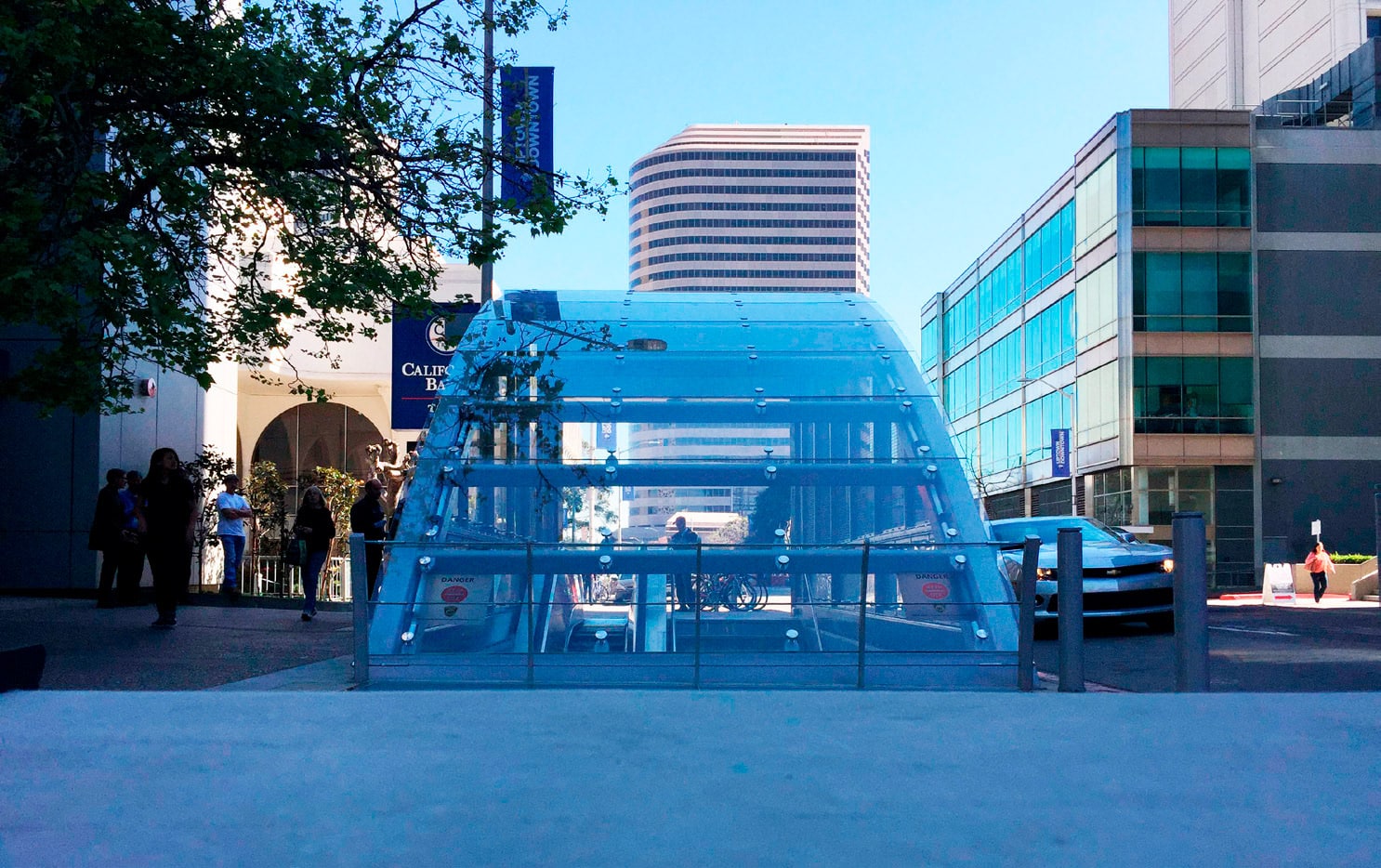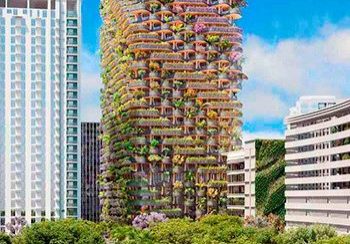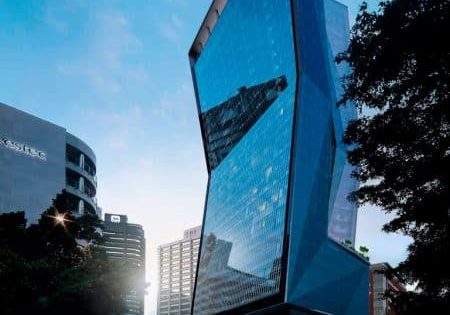Making History in San Francisco
Apr 1, 2020

BART is implementing systemwide changes, of which a new Schindler escalator system
will be a part.
by Kaija Wilkinson
By early 2029, every escalator serving the four busiest BayArea Rapid Transit (BART) stations along Market Street in downtown San Francisco — Embarcadero, Montgomery, Powell and Civic Center/United Nations — is scheduled to be replaced with a heavy-duty Schindler 9700 transit unit. Awarded to Schindler in late 2019, the 41-escalator contract is part of a historic renovation of the BART system — the US$96.4-million Market Street Escalators Renovation Project— that includes canopies to protect the equipment.
This month, Schindler crews began arriving onsite, with Schindler telling ELEVATOR WORLD it will have three to five crews consisting of six to 10 installers each at the stations at any given time. Schindler observes:
“The contract is the largest to replace escalators in BART’s history. Many of the units being replaced are among the oldest in the entire BART system, which started service in 1972. Passenger demand has increased over the years at the downtown stations, with Civic Center/United Nations (UN) Plaza acting as a major hub for passengers moving through the San Francisco Bay Area. Embarcadero and Montgomery stations are only minutes away from Salesforce Tower — the city’s new landmark building and the tallest office tower west of Chicago [for which Schindler provided the elevator system].”
Escalators are vital to the stations, which have a weekday passenger average equivalent to the population of a small city: 25,547 at Civic Center/UN Plaza,[1] 42,874 at Embarcadero,[2] 43,661 at Montgomery Street[3] and 28,876 at Powell Street.[4] All stations are shared with the MUNI Metro.
Serving airports, railroad stations and subways around the world, 9700 escalators have components that meet mass-transit specifications. The units are modular, and their drives, chains, tracks and trusses are customizable. BART Board of Directors President Bevan Duffy describes their installation along Market Street as a “vital milestone.” Having a single technology — the 9700s — at the stations will make the entire system more efficient and easier to maintain, he states.
Generally, specifications will vary depending on locations within the stations, according to Schindler. Key specs include:
- Rise: 10-40 ft
- Speed: 100 ft/min (all units)
- Length: 40-70 ft
- Depth: 5.6 ft
Work will be done concurrently at the stations, with restrictions to avoid excessive disruption to station operations. Completion timelines will hinge on coordination
with other ongoing improvements, such as installation of the canopies.
Canopies and Other Improvements
The success of BART’s pilot escalator canopy at the 19th Street station in Oakland led to canopies at two additional stations — Civic Center/UN Plaza and Powell Street — that are part of the Market Street project. Despite city leaders’ trepidation over what one supervisor called “fancy, US$5- million tents”[5] in early 2020, the BART Board of Directors approved a US$63-million contract to construct 19 additional canopies over station entrances along Market Street, with an option for three more once funding is identified. The custom structures are outfitted with real-time digital displays showing train arrival times, retractable gates, LED lighting and security cameras. The plan is to incorporate local artwork into their ceilings. Funded by city and state bonds, the canopy project is set to start sometime this spring, with the entire project taking seven years so no more than one entrance per station will be under construction at any given time.
The canopies are part of what BART calls “a more systematic, prioritized focus on a state of good repair for elevators and escalators,” which are vital to smooth system operation. In addition to new escalators and canopies, BART is implementing a pilot remote-monitoring system for 83 vertical-transportation (VT) units at six of the busiest stations: Embarcadero, Montgomery Street, Powell Street, Civic Center/UN Plaza, and the 12th and 19th street stations in Oakland. Of this program, BART Power and Mechanical Superintendent Michael Lemon says:
“We’re very excited about the potential for this pilot program. In some cases, it may even be able to send us a self-diagnosis of what the issue is, so we can send the right technicians with the right tools and get a unit back up and running in the same trip.”
After elevators, BART says its top priority is the escalator system. BART points out a single 10-car train can offload more than 1,000 passengers at one stop and that trains come every few minutes to stations like Embarcadero and Powell. Without escalators, platforms at these stations would become “dangerously overcrowded,” BART says. “Escalators take a beating and are complex machines; a single one can have more than 15,000 moving parts,” BART points out.
In total, BART has 138 elevators and 175 escalators at 48 area stations. Their care and feeding is challenging, as they are made by 14 different companies, some of which are no longer in business, and spare parts can be difficult to find. The system is maintained by a staff of just over 40 people, who, Lemon says, “have to be creative” to get the job done. Much of BART’s resources — approximately 60%— go toward maintaining equipment at the four Market Street stations.
Programs See Success
As it deals with ongoing challenges. including finding qualified labor, BART has several achievements under its belt. Over the last several years, it has:
- Replaced flooring in all passenger elevators
- Upgraded protective material on elevator sides to prevent liquid from flowing under the subfloor and damaging equipment/causing odor
- Installed two new elevators in the paid area of Union City Station
- Renovated the older four-unit bank of elevators, which were chronically BART’s increased shows; photo by poor performers, in the Pleasant Hill Station parking structure
- Replaced all elevator emergency call boxes
- Installed a new, higher-capacity and faster elevator inside the paid area from concourse to platform at the Embarcadero Station
- Installed a new elevator from concourse to platform at the 19th Street Station
In addition to new escalators and canopies, BART is implementing a pilot remote-monitoring system for 83 VT units at six of the busiest stations.
The VT equipment in the downtown BART stations (and the stations themselves) are impressively clean. A friend of EW was recently in San Francisco, and she reports the escalators and elevators were literally sparkling, a sentiment echoed on social media by other BART riders in late 2019. BART collects up to 6,000 rider questionnaires per quarter to see if efforts like a ramped-up focus on cleanliness are yielding fruit. The system built up its housekeeping staff throughout 2019, with new General Manager Robert “Bob” Powers adding 15 cleaners to the BART System Services staff in his first six months in office. In a YouTube video posted by BART, these individuals are seen picking up trash and operating equipment like floor buffers and high-powered sprayers to remove debris from all the nooks and crannies. This work takes place overnight when ridership is lower.
Elevator attendants, the result of a pilot program launched in April 2018 at the Civic Center and Powell Street stations, have also proven successful.
According to BART’s performance report for the fourth quarter of 2019, elevator cleanliness saw the highest jump, with 58.1% of riders providing a “good” or “excellent” rating, compared with 42.8% in the same timeframe a year before. Escalator cleanliness also improved slightly, according to riders, which BART attributes to programs like the beefed-up cleaning staff and attendants. “Zero reports of misuse of elevators” at Civic Center/UN Plaza and Powell Street stations have been received since the addition of the attendants, which, in fall 2019, were added to the Embarcadero and Montgomery stations.
Besides simply being more comfortable, better BART stations with new (and clean) escalators “will make the system more reliable for riders, ultimately enhancing the commuter experience with equipment operating as it should, safely and efficiently, to help the public enter and exit the stations,” Schindler says.
A friend of EW was recently in San Francisco, and she reports the escalators and elevators were literally sparkling, a sentiment echoed on social media by other BART riders in late 2019.
References
[1] wikipedia.org/wiki/Civic_Center/UN_Plaza_station
[2] wikipedia.org/wiki/Embarcadero_station
[3] wikipedia.org/wiki/Montgomery_Street_station
[4] wikipedia.org/wiki/Powell_Street_station
[5] Sabatini, Joshua. “Supes Suffer Sticker Shock Over Cost of BART’s ‘Fancy Tents’ to
Cover Escalators,” San Francisco Examiner, July 17, 2019.
Get more of Elevator World. Sign up for our free e-newsletter.







